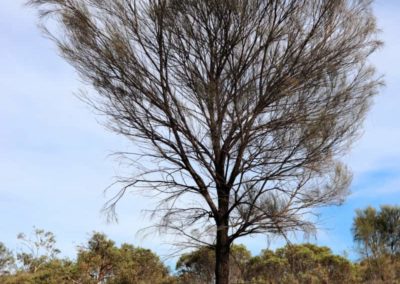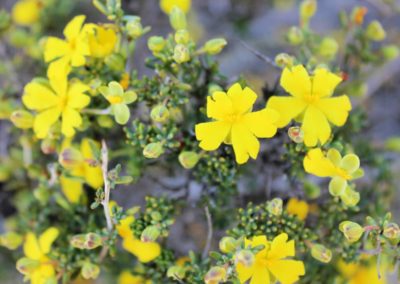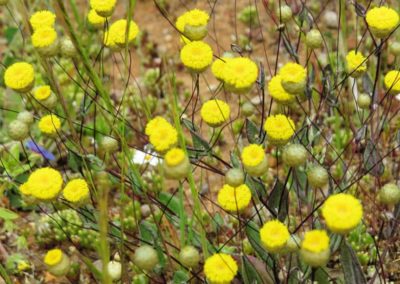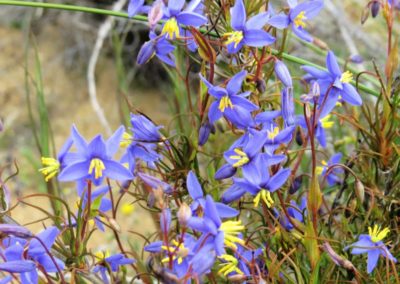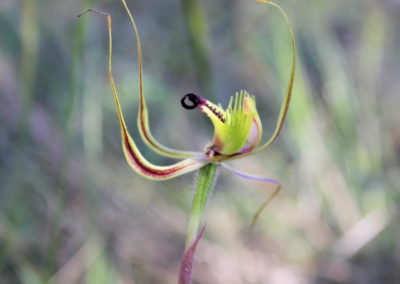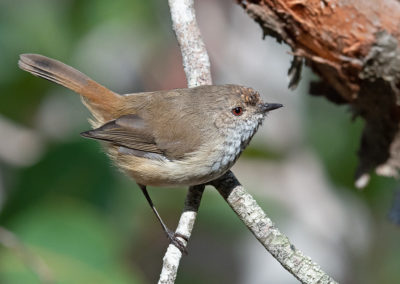Overview
In a landscape dominated by agriculture, Wingedyne Reserve is a precious haven of original vegetation.
This 254ha reserve features a remarkable range of vegetation types in a very small area – including woodlands, mallees, tall shrublands, heathlands and breakaways, associated with species such as Wandoo, Rock Sheoak, Drummond Gum, Silver Mallet, Jarrah, Jam, Banksia and Hakea.
These precious fragments of vegetation in the landscape, and the variety of ecosystems they contain, provide habitat for many endangered animal species including the red-tailed phascogale, numbat, chuditch and Carnaby’s Black Cockatoo.
This beautiful patch of vegetation is also mostly free of weeds, which is rare in small reserves surrounded by farmland.
In The Song of the Dodo (1996), David Quammen describes an ecosystem as being like a Persian carpet. Cut it into tiny squares, and unfortunately you don’t get get tiny carpets, but a lot of useless scraps of material fraying at the edges.
While it can be seen as a tiny fragment, Wingedyne Reserve is an exception to the rule and is an important reserve because it has retained much of its ecological health and it is ‘fraying at the edges’ to a much lesser extent than most similar sized reserves in the Wheatbelt.
Story of the place
Watch
Neighbouring farmer John Pickford outlines his extensive landcare work
Credit: South West Catchments Council
Listen
Noongar Boodja
Woodanilling is part of the Wiilman country of the Noongar Nation. There is plenty of evidence in the broader Woodanilling region of Noongar custodianship of the country, with gnamma in the granite and scar trees.
A rare patch
Wingedyne Reserve is in a part of the Wheatbelt that has been substantially cleared for agriculture – with just a little over 10% of the original native vegetation left.

Salinity affected salt lake in Woodanilling
Image: Nicole Hodgson
This high rate of clearing has resulted in one of the most salt affected areas in Western Australia’s south-west.
More than 15 per cent of land in the Woodanilling area has been lost to dryland salinity, with a further 15 per cent of remnant vegetation and agricultural land at high risk of salinisation in the future.
In such a highly impacted landscape, healthy nature reserves like Wingedine Reserve become absolutely critical – vitally important ecological islands.
The Wheatbelt country to the north and east of Woodanilling is mostly flat, with ranges of low hills and broad shallow valleys.
The Woodanilling area is slightly more undulating, with some small remnants of laterite cappings on ridges and mesas, some granite domes and tors, and broad valleys.

View across Wingedyne Reserve to ridge
Image: Nicole Hodgson
Settler History
Woodanilling was named after a local spring. The name relates to the place of (or pertaining to) small fishes.

Early settlers at nearby Kenmare Hall
In the 1850s the opening of the Albany to Perth road brought pastoralists into the Shire. Around this time, the sandalwood cutters were working their way through the Great Southern and they rapidly cut out all the sandalwood growing in the area.
In the late 19th century an extensive railway system was established throughout the Great Southern, sparking widespread settlement of farmers in Woodanilling and beyond.
By the early 1900s Woodanilling’s population reached a high of over 800. Like many similar towns in the WA wheatbelt, the population has decreased over time as conditions for farming have changed. There are now about 400 people living in Woodanilling.
Wingedyne area is settled
Wingedyne Soak on the neighbouring farm has been heritage listed. It was originally a stone lined well but has since been excavated to the size of a small dam.
Land surrounding the soak was first surveyed in 1906 and was taken up by Charles Leopard who built a fine stone house. The land changed hands a number of times, until about forty years ago it was sold to the Pickford family, the present owners.
Gen Harvey
Wagin-Woody Landcare Zone
“Wingedyne Reserve is a place that has never been grazed. And a lot of these reserves in the district have at some point, been grazed and had some impacts and you’ve lost some of the diversity.
…it’s just interesting that this has a nice diversity, a bit of a snapshot of the landscape – jarrah forest, wandoo woodland, red gum patches, mallet outcrops on the breakaway country. They’re not great big areas of these vegetation communities, but you’ve got little snippets of the most dominant vegetation communities in the Woodanilling area.”
Good neighbours
One reason contributing to the excellent condition of Wingedyne Reserve is that neighbouring landholders are leaders in the local landcare movement.

Remnant vegetation on neighbouring property
Image: Nicole Hodgson
John and Diana Pickford have farmed in Woodanilling for more than 40 years. When they arrived their farm suffered waterlogging, erosion and salinity – forcing the family to implement an extensive revegetation program to rebalance the water table.
More than 50 tree plots have been planted, together with perennial species suited to the differing soil types.
The Pickfords are close to achieving their goal of keeping every drop of water on the farm, improving both production and environmental outcomes.
Their farm is often used to host scientific trials and has been the subject of economic modelling. This research found that for every $1 the Pickfords invested in land care strategies, they received $2.70 in return from increased yields and more efficient livestock production.
Wingedyne Reserve benefits from having such good neighbours, who are actively managing salinity and excess water on their farm, minimising weed disturbance in the reserve, as well as adding biodiversity to the immediate landscape, creating important corridors of habitat that enhances the ecological value of the reserve.
Bioblitzers
Wingedyne Reserve was chosen as the site of a Bioblitz in 2017, organised by the Wagin-Woodanilling Landcare group, because of the biodiversity values and overall health of this reserve.
A Bioblitz is a collaborative, community-based, biological survey that is held over a twenty-four hour period. It brings together professional and amateur biologists, ecologists and naturalists who work together as ‘citizen scientists’ to conduct fieldwork. The outcome is a rapid assessment of site-specific biodiversity values and threats, a useful baseline for future monitoring and management of the reserve.

The full report can be found here but read on for more details of what the Bioblitzers found in the Wingedine Reserve.
See & Do
Short scenic drive
As you drive down Carters Rd the reserve will be on the left with farmland on the right. The impressive remnant vegetation on top of ridges on the neighbouring property will be evident just before the reserve begins.
The first ecosystem evident will be an open wandoo woodland. This is the best area to park carefully on the side of the road, and walk through the open woodland.
The road then veers left slightly as the topography rises. Observe how that slight change in topography and soil changes the vegetation quite substantially. There is less wandoo, a much thicker understorey of banksia species and more mallee eucalypt forms.
Gen Harvey
Wagin-Woody Landcare
“As far as our wildlife is concerned for places like Wingedyne the biggest threat, I think would be the feral predators. Because for example, the Black Glove wallaby that’s out there (there’s only a handful of them) and it only takes one or two foxes to kill them…”
Plantlife
The lower woodland areas are dominated by wandoo (Eucalyptus wandoo). There is a stand of brown mallet (Eucalyptus astringens) on the laterite mesas and breakaways. Some of the species to look out for include:

Brown mallet on breakaway
Image: Nicole Hodgson
The mallet is associated with lateritic soils and breakaways. There is a small ridge in the middle of the Wingedyne Reserve that has a stand of mallet.
Historically the brown mallet was valued for the bark, which has a high tannin content. It was widely used in the process of tanning leather until synthetic substitutes were found. There was a thriving mallet industry in the WA Wheatbelt at the turn of the 20th century.

Wandoo
Image: Nicole Hodgson
Wandoo is used by so many different species of animal that it has been called ‘nature’s boarding house’.
The mature trees eventually create hollows that provide homes for a range of animals, including the red-tailed phascogale. The Woodanilling area has a reasonable population of this endangered mammal, one of many reasons why reserves with mature wandoo trees are so important.
Wildflowers and Orchids
The 2017 Bioblitz at Wingedine recorded 200 plant species, as well as 12 fungi and lichen. Some of the species you are most likely to see include:
During the Bioblitz, the following orchid species were recorded:
Small-flowered Donkey Orchid (Diuris porrifolia)
Small-flowered Donkey Orchid (Diuris porrifolia). Image: Anne Rick
Pink enamel orchid (Elythranthera emarginata)
Pink enamel orchid (Elythranthera emarginata). Image: Sue O’Halloran
Purple Enamel Orchid (Elythranthera brunonis)
Purple Enamel Orchid (Elythranthera brunonis). Image: Sue O’Halloran
Animal life
European settlement has had a profound impact on the mammal species of the Wheatbelt and south-western Australia as a whole. Of the original 43 species recorded, 17 are now locally extinct. Only 12 of the remaining species are considered to be moderately common to abundant.
The 2017 Bioblitz at Wingedine Reserve recorded 215 animal species – the majority of which were invertebrates.
Three reptile species were identified: Gould’s Monitor, Southern Blind Snake, and the Bobtail/ Shingleback.

Black-gloved wallaby
Image: Paula Deegan
A number of mammals were identified during the Bioblitz via scats, including the Brush-tailed Possum and Black-gloved Wallaby (or Brush Wallaby). However, foxes were also detected.
Footage from motion sensing cameras placed on the reserve prior to the Bioblitz recorded Western Grey Kangaroos in high numbers and the presence of feral cats.
It is hoped that the endangered Red-tailed Phascogale is also present in the Wingedyne Reserve, however, as it is a tree-dwelling, nocturnal species, it is highly unlikely that a casual visitor will spot one.
Bird life
Woodanilling is known as a good area to spot birds, because of the mix of open country, nature reserves and lake / river systems. There is also a distinct change in the landscape from the drier eastern end towards the wetter country in the west, which attracts different species across the gradient.
Birds are prolific in the Woodanilling area, but overall, birds are in decline. When compared with fifty years ago, bird populations have declined across south-western Australia.
44 different species were identified during the Bioblitz in 2017. These include:
Download the full list of bird species found at Wingedyne Reserve:
Giving back and getting involved
Wagin-Woodanilling Landcare Zone is the local landcare group in this area. Contact them to find out more about opportunities to get involved.
Nearby
There are many other sites to visit nearby including:
Practical Information
Directions
From Woodanilling travel west on Robinson Rd for 19km. Turn left onto Carters Rd. The reserve begins on the left side of the road, just 2.2km from the intersection.
Stop safely
There are no facilities at Wingedine Reserve, and no dedicated area to pull over. If you do stop on the side of the road, make sure to stop in a safe spot and pull over as far as possible to the edge of the road.
Responsible tourism
This is a healthy, intact reserve, so please do your best to keep it that way. Practice good dieback hygiene, and please make sure to Leave No Trace.
When to go
As with most places in south-western Australia, it is worth visiting during the wildflower season during Djilba and Kambarang (August to November) when most of the plants are flowering.
Where to eat and stay
See the suggestions from our friends at Great Southern Treasures:




